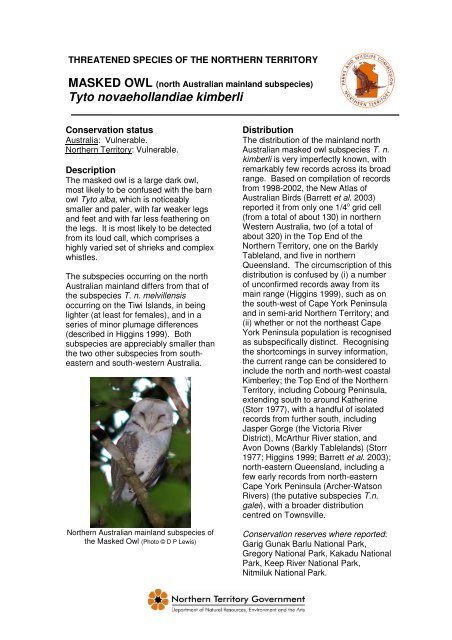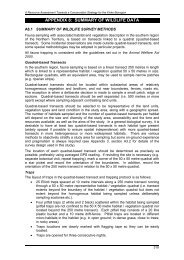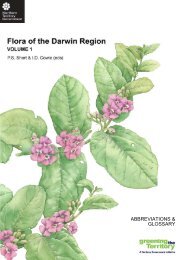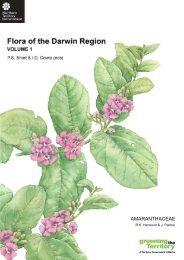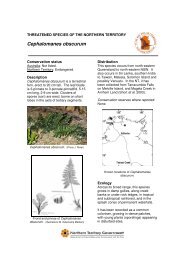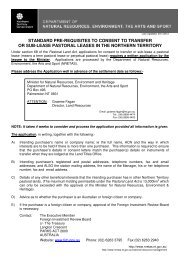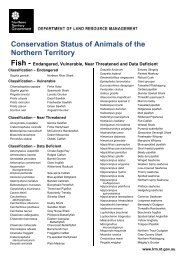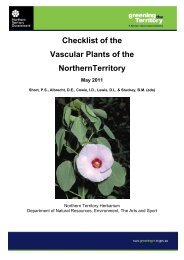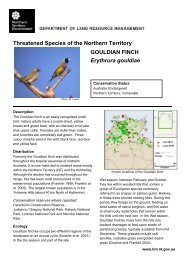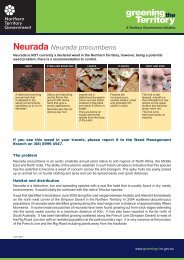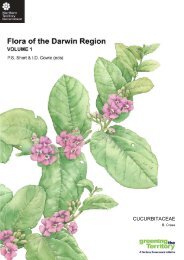Tyto novaehollandiae kimberli - Department of Land Resource ...
Tyto novaehollandiae kimberli - Department of Land Resource ...
Tyto novaehollandiae kimberli - Department of Land Resource ...
You also want an ePaper? Increase the reach of your titles
YUMPU automatically turns print PDFs into web optimized ePapers that Google loves.
THREATENED SPECIES OF THE NORTHERN TERRITORY<br />
MASKED OWL (north Australian mainland subspecies)<br />
<strong>Tyto</strong> <strong>novaehollandiae</strong> <strong>kimberli</strong><br />
Conservation status<br />
Australia: Vulnerable.<br />
Northern Territory: Vulnerable.<br />
Description<br />
The masked owl is a large dark owl,<br />
most likely to be confused with the barn<br />
owl <strong>Tyto</strong> alba, which is noticeably<br />
smaller and paler, with far weaker legs<br />
and feet and with far less feathering on<br />
the legs. It is most likely to be detected<br />
from its loud call, which comprises a<br />
highly varied set <strong>of</strong> shrieks and complex<br />
whistles.<br />
The subspecies occurring on the north<br />
Australian mainland differs from that <strong>of</strong><br />
the subspecies T. n. melvillensis<br />
occurring on the Tiwi Islands, in being<br />
lighter (at least for females), and in a<br />
series <strong>of</strong> minor plumage differences<br />
(described in Higgins 1999). Both<br />
subspecies are appreciably smaller than<br />
the two other subspecies from southeastern<br />
and south-western Australia.<br />
Northern Australian mainland subspecies <strong>of</strong><br />
the Masked Owl (Photo © D P Lewis)<br />
Distribution<br />
The distribution <strong>of</strong> the mainland north<br />
Australian masked owl subspecies T. n.<br />
<strong>kimberli</strong> is very imperfectly known, with<br />
remarkably few records across its broad<br />
range. Based on compilation <strong>of</strong> records<br />
from 1998-2002, the New Atlas <strong>of</strong><br />
Australian Birds (Barrett et al. 2003)<br />
reported it from only one 1/4 o grid cell<br />
(from a total <strong>of</strong> about 130) in northern<br />
Western Australia, two (<strong>of</strong> a total <strong>of</strong><br />
about 320) in the Top End <strong>of</strong> the<br />
Northern Territory, one on the Barkly<br />
Tableland, and five in northern<br />
Queensland. The circumscription <strong>of</strong> this<br />
distribution is confused by (i) a number<br />
<strong>of</strong> unconfirmed records away from its<br />
main range (Higgins 1999), such as on<br />
the south-west <strong>of</strong> Cape York Peninsula<br />
and in semi-arid Northern Territory; and<br />
(ii) whether or not the northeast Cape<br />
York Peninsula population is recognised<br />
as subspecifically distinct. Recognising<br />
the shortcomings in survey information,<br />
the current range can be considered to<br />
include the north and north-west coastal<br />
Kimberley; the Top End <strong>of</strong> the Northern<br />
Territory, including Cobourg Peninsula,<br />
extending south to around Katherine<br />
(Storr 1977), with a handful <strong>of</strong> isolated<br />
records from further south, including<br />
Jasper Gorge (the Victoria River<br />
District), McArthur River station, and<br />
Avon Downs (Barkly Tablelands) (Storr<br />
1977; Higgins 1999; Barrett et al. 2003);<br />
north-eastern Queensland, including a<br />
few early records from north-eastern<br />
Cape York Peninsula (Archer-Watson<br />
Rivers) (the putative subspecies T.n.<br />
galei), with a broader distribution<br />
centred on Townsville.<br />
Conservation reserves where reported:<br />
Garig Gunak Barlu National Park,<br />
Gregory National Park, Kakadu National<br />
Park, Keep River National Park,<br />
Nitmiluk National Park.
Known locations <strong>of</strong> the north Australian<br />
mainland subspecies <strong>of</strong> the masked owl.<br />
O = pre 1970; • = post 1970<br />
Ecology<br />
The masked owl occurs mainly in<br />
eucalypt tall open forests (especially<br />
those dominated by Darwin woollybutt<br />
Eucalyptus miniata and Darwin<br />
stringybark E. tetrodonta), but also<br />
roosts in monsoon rainforests, and<br />
forages in more open vegetation types,<br />
including grasslands. Although it may<br />
roost in dense foliage, it more typically<br />
roosts, and nests, in tree hollows.<br />
Mammals, up to the size <strong>of</strong> possums,<br />
constitute the bulk <strong>of</strong> its diet (Higgins<br />
1999).<br />
Although there is no detailed<br />
information for this subspecies, masked<br />
owls <strong>of</strong> other subspecies occupy large<br />
exclusive home ranges, estimated at 5-<br />
10 km 2 (Kavanagh and Murray 1996).<br />
Conservation assessment<br />
Too little information is known about the<br />
distribution, population size and trends<br />
in population to ascribe conservation<br />
status with any confidence. In northeastern<br />
Queensland, the subspecies is<br />
considered to be in decline (Nielsen<br />
1996). Given the large home ranges<br />
needed by the species, the population<br />
<strong>of</strong> mainland masked owls in the NT is<br />
probably fewer than 10,000 breeding<br />
Threatened Species Information Sheet<br />
individuals. Given the probability that<br />
the population is declining in the NT at a<br />
rate <strong>of</strong> more than 10% in a 15 year<br />
period (an estimated period for three<br />
generations), the subspecies qualifies<br />
as Vulnerable under criterion C1:<br />
• population size estimated to<br />
number fewer than 10,000<br />
mature individuals, and<br />
• an estimated continuing decline<br />
<strong>of</strong> at least 10% within 10 years<br />
or three generations, whichever<br />
is longer.<br />
Threatening processes<br />
There is no reliable information on what<br />
factors may affect the status <strong>of</strong> this<br />
subspecies. It is possible that food<br />
resources may be diminishing, through<br />
broad-scale decline <strong>of</strong> small and<br />
medium-sized native mammals,<br />
possibly due to changed fire regimes<br />
(Woinarski et al. 2001; Pardon et al.<br />
2003). This would lead to a subsequent<br />
decline in the masked owl population.<br />
The greatly increased cover and height<br />
<strong>of</strong> invasive exotic grasses (Rossiter et<br />
al. 2003) may cause a reduction in<br />
foraging efficiency for this owl.<br />
The current regime <strong>of</strong> more intense,<br />
frequent and extensive fires may reduce<br />
the availability <strong>of</strong> large trees and<br />
hollows (Williams et al. 1999, 2003)<br />
required for nesting. Conversely, more<br />
extensive and less patchy fires may<br />
lead to greater foraging efficiency<br />
(Oakwood 2000).<br />
Conservation objectives and<br />
management<br />
A national recovery plan for the<br />
mainland masked owl, and other birds,<br />
has recently been established<br />
(Woinarski 2004).<br />
Recent studies on the Tiwi Islands have<br />
demonstrated that playback <strong>of</strong> calls is<br />
likely to significantly increase probability<br />
<strong>of</strong> detection <strong>of</strong> this species (Woinarski<br />
et al. 2003). The main research priority<br />
is to derive more precise information on<br />
population size, home range, habitat
equirements, and response to putative<br />
threatening processes. A monitoring<br />
program should be established for at<br />
least representative populations.<br />
Compiled by<br />
John Woinarski<br />
Simon Ward<br />
[May 2006]<br />
References<br />
Barrett, G., Silcocks, A., Barry, S.,<br />
Cunningham, R., and Poulter, R.<br />
(2003). The new atlas <strong>of</strong> Australian<br />
birds. (Royal Australasian<br />
Ornithologists Union, Melbourne.)<br />
Higgins, P.J. (1999). Handbook <strong>of</strong><br />
Australian, New Zealand and Antarctic<br />
birds. Volume 4. Parrots to<br />
Dollarbirds. (Oxford University Press,<br />
Melbourne.)<br />
Kavanagh, R.P., and Murray, M. (1996).<br />
Home range, habitat and behaviour <strong>of</strong><br />
the masked owl <strong>Tyto</strong> <strong>novaehollandiae</strong><br />
near Newcastle, New South Wales.<br />
Emu 96, 250-257.<br />
Nielsen, L. (1996). Birds <strong>of</strong> Queensland’s<br />
Wet Tropics and Great Barrier Reef<br />
Australia. (Gerard Industries,<br />
Bowden.)<br />
Oakwood, M. (2000). Reproduction and<br />
demography <strong>of</strong> the northern quoll,<br />
Dasyurus hallucatus, in the lowland<br />
savanna <strong>of</strong> northern Australia.<br />
Australian Journal <strong>of</strong> Zoology 48, 519-<br />
539.<br />
Pardon, L.G., Brook, B.W., Griffiths, A.D.,<br />
and Braithwaite, R.W. (2003).<br />
Determinants <strong>of</strong> survival for the<br />
northern brown bandicoot under a<br />
landscape-scale fire experiment.<br />
Journal <strong>of</strong> Animal Ecology 72, 106-115.<br />
Rossiter, N.A., Setterfield, S.A., Douglas,<br />
M.M., and Hutley, L.B. (2003). Testing<br />
the grass-fire cycle: alien grass<br />
invasion in the tropical savannas <strong>of</strong><br />
northern Australia. Diversity and<br />
Distributions 9, 169-176.<br />
Schodde, R., and Mason, I.J. (1980).<br />
Nocturnal birds <strong>of</strong> Australia.<br />
(Lansdowne, Melbourne.)<br />
Storr, G.M. (1977). Birds <strong>of</strong> the Northern<br />
Territory. Special Publication no. 7.<br />
(Western Australian Museum, Perth.)<br />
Williams, R.J., Cook, G.D., Gill, A.M., and<br />
Moore, P.H.R. (1999). Fire regimes,<br />
fire intensity and tree survival in a<br />
tropical savanna in northern Australia.<br />
Threatened Species Information Sheet<br />
Australian Journal <strong>of</strong> Ecology 24, 50-<br />
59.<br />
Williams, R.J., Muller, W.J., Wahren, C-H.,<br />
Setterfield, S.A., and Cusack, J.<br />
(2003). Vegetation. In Fire in tropical<br />
savannas: the Kapalga experiment.<br />
(eds A.N. Andersen, G.D. Cook and<br />
R.J. Williams.) pp. 79-106. (Springer-<br />
Verlag, New York.)<br />
Woinarski, J.C.Z. (2004). National multispecies<br />
Recovery Plan for the<br />
Partridge Pigeon [eastern subspecies]<br />
Geophaps smithii smithii; crested<br />
shrike-tit [northern (sub)-species]<br />
Falcunculus (frontatus) whitei; masked<br />
owl [north Australian mainland<br />
subspecies] <strong>Tyto</strong> novaehollandae<br />
<strong>kimberli</strong>; and masked owl [Tiwi Islands<br />
subspecies] <strong>Tyto</strong> <strong>novaehollandiae</strong><br />
melvillensis, 2004-2008. (NT<br />
<strong>Department</strong> <strong>of</strong> Infrastructure Planning<br />
and Environment, Darwin.)<br />
Woinarski, J.C.Z., Milne, D.J., and<br />
Wanganeen, G. (2001). Changes in<br />
mammal populations in relatively intact<br />
landscapes <strong>of</strong> Kakadu National Park,<br />
Northern Territory, Australia. Austral<br />
Ecology 26, 360-370.<br />
Woinarski, J., Brennan, K., Hempel, C.,<br />
Armstrong, M., Milne, D., and Chatto,<br />
R. (2003). Biodiversity conservation on<br />
the Tiwi islands, Northern Territory.<br />
Part 2. Fauna. 127 pp. (<strong>Department</strong><br />
<strong>of</strong> Infrastructure Planning and<br />
Environment, Darwin.)


